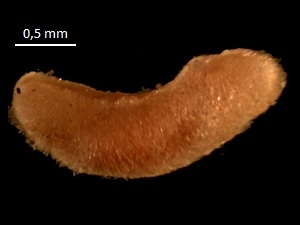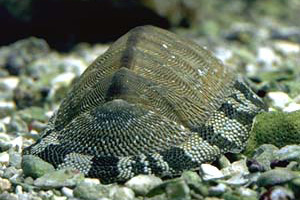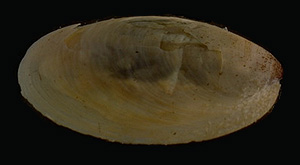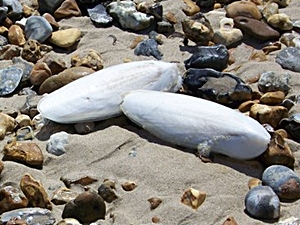
The Molluscs' shell is built differently in the various groups.

The Molluscs' shell is built differently in the various groups.
![]() Guide the mouse
over the pictures to be informed on each group.
Guide the mouse
over the pictures to be informed on each group.
Source: Mizzaro-Wimmer, Salvini-Plawen: "Praktische Malakologie", Vienna 2001.
 An unidentified solenogaster (Neomenia spec.). The furry exterior actually is due to a multitude of tiny calcareous spikes (spiculi). Source: MBARI. |
Molluscs' calcareous shell makes them very different from other animals, various as they may be. The assumption, the first molluscs of the early Cambrian period (about 550 to 580 Million years ago) had been creatures crawling on the ocean floor, explains the division of a mollusc's body into a soft ventral side crawling on the floor and a dorsal side exposed to the environment, which had to be protected to improve the species' capability to survive.
Looking at the different forms of protection in today's molluscs, it may be assumed that the earliest molluscs did not possess a shell. Instead, their dorsal side was protected by a thick tissue layer covering the vulnerable inner organs like a coat. This tissue layer today is referred to as the mantle or scientifically as pallium. In the most ancient molluscs the mantle was covered by a hard cuticula of a horn-like material.
Calcium carbonate taken in with the food was assembled in the cuticula, rendering it additionally resistive. The most ancient molluscs alive today are the so-called aplacophorans, Caudofoveata and Solenogastres. Though these groups have certainly evolved further since the Cambrian, this state today is estimated nearest to the basic original. Both groups possess a hard cuticula strengthened with calcareous scales in the Caudofoveata and calcareous spikes (spiculi) in the Solenogastres.
 A chiton. The striped marginal area is the girdle, all that re- mains of the first molluscs' cuticula. Source: Invertébrés Herbivores. |
Today's chitons' (Polyplacophora) ancestors, in contrary to that, present a further development of evolution. Instead if single calcareous spikes or scales the dorsal side of those molluscs is protected by several shell plates overlapping like a knight's armour plates.
The cuticula rendered unnecessary by the improved protection of the dorsal shell plates has been pushed to the unprotected lateral parts of the chiton to protect those as girdle.
The chitons of today mainly inhabit the tidal zone where their scale armour makes it possible for the animal to roll together, should it fall off the rock. Molluscs of other habitats could achieve a better protection when their shell plates melted together to form one single shell covering all of the body, leaving no place unprotected.
 A conserved specimen of Neopilina galatheae. |
In fact this design proved to be so successful that all other molluscs in their original state remain with it: Together with the development of a single shell the last remainders of a cuticula were removed from mollusc evolution. Today it is assumed that the first shell-bearing molluscs (referred to scientifically as Conchifera) resembled today's Tryblidia, a very ancient group of Conchifera, which until the 1950s had been though extinct since the Cambrian period. Surprisingly the oceanographic Galathea expedition found some specimens of Neopilina off the coast of Coast Rica. Neopilina is a classic living fossil, most of its relatives extinct for millions of years.
Today's higher molluscs have evolved to an astounding diversity of forms, all based on the common construction of a one-part shell. Molluscs thus were able to adapt to all possible life forms and habitats, even to settle on dry land, where the shell additionally protects its owner against desiccation.
 Shell halves of the large pond mussel (Anodonta cygnea). Source: M. Kohl: European Unionaceans. |
But nonetheless the mollusc shell is not an exoskeleton; it does not statically support the body, the latter maintaining its form mainly by blood pressure. The shell is built by the secretion of special lime producing cells situated all over the mantle, but specially concentrated at the mantle's edge. When the mollusc grows, so does the mantle and the shell with it.
Mussels and clams (Bivalvia) seem to have diverged from the original plan by adapting to an unmoving life. Their shell is divided during embryonic development and develops two separate shell halves held together by an elastic band, the ligament. This is unique among the molluscs and has also led to the scientific name Bivalvia, the two-half molluscs. Above all, the bipartite shell of the bivalves enables the animal only to extend its siphon to breathe, to feed and to reproduce, without having to expose any other part of the body.
 Cuttlebones of a common cuttlefish (Sepia officinalis) on a beach in Southern England. Picture: Trish Steel (Source). |
The shell of a snail (Gastropoda), differently from all other mollusc shells, is coiled to form characteristic spiral. During their evolution, snails have developed a dorsal sack, the visceral hump, to contain most of the internal organs. Protected by the mantle, the visceral hump is among those parts of a snail's body always to remain inside the shell. During the embryonic development of snails the so-called torsion happens: The complex of mantle and visceral hump turns around and coils into a spiral saving space. So, the shell of a gastropod, other than all other comparable mollusc shells, is coiled asymmetrically to one side (left or right).
![]() See also:
The Gastropod Shell.
See also:
The Gastropod Shell.
An elephant tusk's (Scaphopoda) shell is specially adapted to the way of life of these creatures burrowing for food, microscopic beings, in the ocean ground. An elephant tusk shell is hollow and open on both ends, one for the burrowing foot of the animal, one for respiration, open to the surrounding water.
Finally the cephalopods (Cephalopoda), the most highly developed mollusc group, demonstrate a strategy of shell development also visible in many terrestrial and marine gastropod groups: A reduction of the shell, at cost of protection but improving movability. As a consequence, the few recent Nautilus species are the only cephalopods left on earth still bearing an external shell.
In contrary to that, cuttlefish and squids only have left an internal shell, which among squids even is reduced to a horn-like rest called a gladius, as it resembles the form of a sword. Cuttlefish's internal shell is larger and still completely made of lime. As a cuttlebone it is used to provide cage birds with a means to whet their beaks.
At the end of the evolutionary chain, octopuses do not even have any rest of an internal shell left. So they are able to squeeze through the tiniest openings to pursue a prey or to hide from a predator.